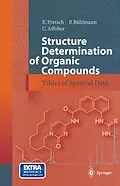This volume presents - in the form of texts, tables, charts and graphs - a modern compilation of spectroscopic reference data for IR, UV/vis, 1H- and 13C-NMR, MS (incl. prototype spectra of almost every important class of organic compounds and spectra of MALDI and FAB matrix materials) and is intended as a short textbook and a hands-on guide for interpreting experimental spectral data and elucidating the structure of the respective compound behind it. The concise texts include special chapters on fragmentation rules in mass spectrometry and on currently used multipulse and 2D NMR techniques. The book is primarily designed for students to be used during courses and exercises; advanced learners may use this book to supplement the understanding of extended textbooks on the topic. The use of the book requires only basic knowledge of spectroscopic techniques, but is structured in such a way that it will support practitioneers routinely faced with the task of interpreting such spectral information, and it will serve as a data reference for specialists in the field.
Klappentext
While modem techniques of nuclear magnetic resonance and mass spectrometry changed the ways of data acquisition and greatly extended the capabilities of these methods, the basic parameters, such as chemical shifts, coupling constants, and fragmentation pathways remain the same. This explains the ongoing success of the earlier editions of this book. However, since the amount of available data has considerably increased over the years, we decided to prepare an entirely new manuscript. It follows the same basic concepts, i. e. , it provides a representative, albeit limited set of reference data for the interpretation of 13C NMR, 1 H NMR, IR, mass, and UV Nis spectra. On the other hand, the book has undergone a number of changes. The amount of reference data has been doubled at least (especially for MS and IR) and the order and selection of data for the various spectroscopic methods is now arranged strictly in the same way. In addition, the the enclosed compact disc contains programs for estimating NMR chemical shifts and generating isomers based on structural information. Unfortunately, our teachers and colleagues, Prof. Wilhelm Simon and Prof. Thomas Clerc are no longer among us, and Prof. Joseph Seibl has retired years ago. Their contributions to developing the concept and the earlier editions of this work cannot be overemphasized. We also thank numerous colleagues who helped us in many different ways to complete the manuscript. Weare particularly indebted to Dr.
Inhalt
1 Introduction.- 2 Summary Tables.- 3 Combination Tables.- 4 13C NMR Spectroscopy.- 5 1H NMR Spectroscopy.- 6 IR Spectroscopy.- 7 Mass Spectrometry.- 8 UV/Vis Spectroscopy.
